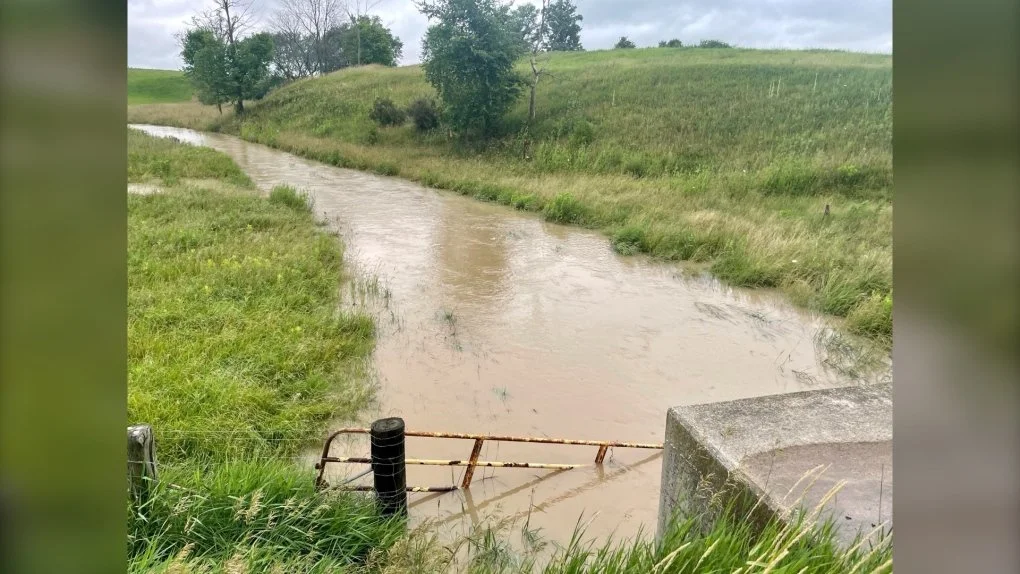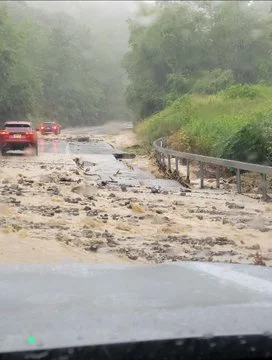Water covers 71% of the Earth’s surface, but good ol’ H2O is a much more precious resource than it appears. Less than 0.8% of Earth’s water is freshwater in lakes, rivers, or underground aquifers. And much of that already tiny fraction has been rendered unusable by pollution or is lost to poor management and inefficient agricultural practices. What’s worse, climate change and overexploitation of existing water resources mean that communities from California to Cambodia are struggling to provide safe water at an affordable price.
‘Air-Conditioning’ Rivers and Streams Could Save Overheated Fish
And a new threat is gradually emerging. Water temperatures are warming, thanks to a combination of climate change and human water management techniques. And in some places they’re growing hot enough to kill the fish. “We’ve seen instances where we’ve had die-offs of coldwater species,” said Kathryn Smith, a doctoral candidate in the Coastal Hydrology Lab at Dalhousie University in Canada.
Pumping cold water into rivers could act as ‘air conditioning’ for fish
When water temperatures get too hot, fish can become stressed or even die. In rivers, Atlantic salmon and other cold-water species sometimes escape the heat by flocking to cooler areas, which often arise near groundwater springs or relatively cool tributaries. Lots of work has been done to preserve and augment these naturally occurring refuges, said Smith, of Dalhousie University in Halifax, Canada, “but there hasn’t really been an emphasis or focus on if we can create cold-water habitat.”
As drought dries up B.C. rivers, conservationists turn to beavers for help
The ongoing drought in many parts of B.C. is causing some rivers in the province's northern Interior to reach their driest mid-October levels in years. In Prince George, the unusually low waters have locals worried. Harriet Schoeter moved to the northern B.C. city 60 years ago, and loves walking the shore where the Fraser and Nechako rivers meet. This week, the water was so low she could almost walk right across.
Discover the 5 Most Polluted Rivers in Canada
For discharge, spills, and waste, river currents carry these pollutants downstream. While sometimes diluted, the pollutants barely break down and begin to fill banks and sediment. It disrupts river ecosystems and lessens the quality of potable water in the Canadian wilderness. Furthermore, the spills that happen include toxic chemicals that natural processes can’t break down. This results in a complete loss of habitat for many aquatic animals.
'We're hoping for some more rain': Extremely low N.W.T. water levels raise concerns about the future
Water levels in rivers and lakes of the central and southern Northwest Territories are at — or near — record lows this year after an extremely hot and dry stretch lasting months. "It's been steadily decreasing all summer and, as a result, the Mackenzie River downstream is also extremely low and record low at different locations," said Ryan Connon, a hydrologist with the Government of the Northwest Territories.
The 10 Clearest Rivers in Canada
Rivers are the veins of Earth through which nourishment flows—to both the natural and human worlds. They cradle vibrant ecosystems and sculpt our landscapes. They are the living henges we build so much culture, recreation, and commerce around. And their clarity, or lack thereof, points to their health, or lack thereof. And in many ways, our rivers’ health mirrors that of our own. In the expansive lands of Canada, many flow hale and lucid.
Canada's lakes are becoming less blue — but that could be good for fish
If you drive the Icefields Parkway through the Canadian Rockies, you'll pass multiple turquoise-coloured lakes that are popular with tourists for taking photos. The lakes get their iconic colour from rock flour, which is similar in appearance to baker's flour used for making bread. Rock flour is made from glaciers grinding rocks into powder, which can take thousands of years.
Ontario Supporting Local Projects to Protect the Great Lakes
The Ontario government is investing $6 million to support 30 multi-year projects to help protect, conserve and restore the Great Lakes. These investments will help reduce plastic litter, excess nutrients and road salt entering lakes, rivers and streams, advance climate resiliency, and make significant progress on restoring environmentally degraded areas of the Great Lakes.
B.C. tightens water use in face of twin crises of wildfires, drought
British Columbia has ordered the oil and gas industry to temporarily stop diverting water to operations in one northeast district, and is now considering banning water use by other industries in other parts of the province, as it tries to conserve resources for its fight against the twin crises of drought and wildfires. At a news conference in Vancouver on Thursday, government officials explained that B.C.’s government is also working with municipalities, regional districts and First Nations to escalate restrictions on personal water usage.
'The ground can’t handle any more water': UTRCA
Rivers, creeks, and streams are beginning to turn amidst the pressure of flood waters. While the City of London escaped heavy rain Wednesday evening through Thursday morning, some areas north and west of the city were not as fortunate. The Upper Thames River Conservation Authority (UTRCA) issued a flood alert. It follows several days of storms that have left the earth saturated.
State of emergency declared in Quebec town due to flood risk, more towns evacuating
A town near Quebec City declared a state of local emergency and other communities ordered preventive evacuations on Tuesday as torrential rain caused rivers across southern Quebec to burst free of their banks. By Tuesday, between 500 and 600 people were forced from their homes in Ste-Brigitte-de-Laval, where the mayor declared a state of emergency for the next 48 hours.
Hudson Valley Flood Emergency Triggers Rescues; Woman Drowns In Orange County, New York
An estimated half-foot of rainfall or more inundated areas of New York's Lower Hudson Valley region on Sunday, washing out roads and overwhelming vehicles to the point that drivers needed to be rescued. One death has been blamed on the flooding. In Orange County, New York, a woman drowned while trying to evacuate her home, according to the Associated Press. "Her house was completely surrounded by water," Orange County Executive Steven Neuhaus told the AP. He added: "She was trying to get through (the flooding) with her dog, and she was overwhelmed by tidal-wave type waves."
How forest fire smoke in the Thunder Bay area is harming waterways
As Canada continues to battle relentless forest fires, Thunder Bay's blue skies are sometimes turning grey with smoke from fires, both near and far. While the smoky air has created serious health risks for vulnerable groups, it is also putting the region's already at-risk waterways in jeopardy. According to Robert Stewart, an associate professor in the geography department at Lakehead University, the majority of the area's rivers are negatively affected by urbanization and storm water, but must now deal with the side effects of climate change.
Texas poised to pour billions into water infrastructure
Climate change has brought higher temperatures in Texas that has accelerated reservoir evaporation and created arid conditions. That has reduced water volumes flowing into rivers and streams. State data indicates reservoir storage was only about 67 per cent of capacity last October from a year earlier. The 30 million people living in Texas cannot survive without water. The state’s rapid economic and population growth has put strain on existing water infrastructure. Even before taking that growth into account, time has taken its toll on water infrastructure, particularly in rural areas. About 132 billion gallons of water were lost in 2021 through breaks, leakage and other causes, according to data submitted by public water suppliers to the Texas Water Development Board (TWDB). Old leaky pipes not only waste water but can increase health risks due to contaminants like arsenic.
Weather, conservation agencies warn heavy rainfall can bring flash floods throughout GTA Social Sharing
Heavy rainfall and isolated thunderstorms are expected to hit pockets throughout the GTA Saturday, which can bring about flash floods, water pools on roads and localized flooding in low-lying areas, Environment Canada warns. The federal weather agency says 50 to 75 millimetres of rain is possible in areas as far west as Guelph to east beyond Kingston. Heavy showers have already begun and are expected to continue on and off throughout the day, with a forecasted end this evening.
"Anticipate challenging conditions": Jasper warns visitors after 70 cm of snow
On Monday, the park received up to 100 mm of precipitation in some areas, falling as both snow and rain. The high-elevation areas, such as the Skyline trail, received an estimated snow accumulation of up to 70 cm, while lower elevations experienced lesser amounts. The heavy snowfall resulted in widespread tree damage, making travel conditions on trails challenging and, in some cases, impassable, with Parks Canada having to rescue dozens of people who were left stranded in some areas.
Washington Farmers Blame Canada for Contaminated Water
A northern Washington farmer advocacy group is calling on Gov. Jay Inslee to act swiftly to address poor water quality in their region due to what they claim is contamination flowing from rivers originating in Canada. In their June 6 letter to Inslee, Whatcom Family Farmers Executive Director Fred Likkel and Northern Lynden Water Improvement District President Larry Stap described the Nooksack River Basin as contaminated with "extremely high levels of bacteria" coming from the other side of the Canadian border. "Given the current issues surrounding international flooding, as well as issues surrounding water rights and an impending adjudication of water rights in Whatcom County, immediate action is imperative on this subject," the letter states.
Supreme Court Decision Undercuts U.S. Clean Water Act
The United States Supreme Court has curtailed the Environmental Protection Agency (EPA)’s authority to protect wetlands from pollution, a ruling that some experts and justices say goes too far by positioning the court as “the national decision-maker on environmental policy.” On May 25, the court ruled that only wetlands with a “continuous surface connection” to larger streams, lakes, and rivers fall under federal protection. This is the second major legal blow to the federal government’s powers for environmental protection, after last year’s SCOTUS decision that the Clean Air Act does not grant the EPA broad authority to regulate greenhouse gas emissions from power plants that contribute to global warming.
Supreme Court limits EPA power to police water pollution Published
The US Supreme Court curtailed the federal government's authority to protect its wetlands from pollution in a decision on Thursday. The court voted only those wetlands with a continuous surface connection to larger streams, lakes and rivers would come under federal protections. The Environmental Protection Agency (EPA) expressed its disappointment. It is the second case in two years where the court limited the EPA's ability to regulate pollution.





















